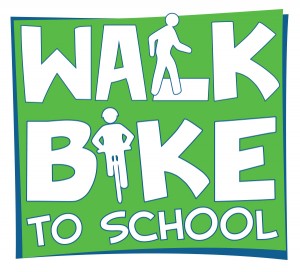Will a “walking school bus” keep kids healthier?

A simple idea, worth encouraging. (Image via walkbiketoschool.org)
A pilot program starting in Ottawa next fall would provide supervised walking groups instead of the traditional school bus.
Of course there would be problems during inclement weather. And this idea won’t work at all for most rural school districts. But in the right neighborhoods, utilizing good old muscle power could counter the problem of low physical activity and rising obesity rates, while retaining a degree of supervision. It could save money too.
Under this proposal, paid adult walk leaders would collect the students and then walk together to school. From CBC coverage:
“We want to make sure that the person will be there every morning to pick up the students on the way to school. Different communities have tried it with volunteers — it is another way to go about it but it is a little more difficult to get the commitment,” said Marie-Claude Turcotte, who’s in charge of the Ottawa Public Health initiative.
The pilot is part of a larger project to implement new walk zones at public and Catholic schools in Ottawa. By September 2015, an estimated 2,500 students could be walking to school rather than riding the bus.
An informal poll included in the CBC article saw nearly 85 percent of respondents agreeing this sounds like a good idea. The same sort of group walking can also be done with volunteers, as detailed by this Walking School Bus website:
A walking school bus is a group of children walking to school with one or more adults. If that sounds simple, it is, and that’s part of the beauty of the walking school bus. It can be as informal as two families taking turns walking their children to school to as structured as a route with meeting points, a timetable and a regularly rotated schedule of trained volunteers.
A variation on the walking school bus is the bicycle train, in which adults supervise children riding their bikes to school. The flexibility of the walking school bus makes it appealing to communities of all sizes with varying needs.
Parents often cite safety issues as one of the primary reasons they are reluctant to allow their children to walk to school. Providing adult supervision may help reduce those worries for families who live within walking or bicycling distance to school.
That website is maintained by another source of similar information, the National Center for Safe Routes to School as well as the University of North Carolina Highway Safety Research Center, with funding provided by the U.S. Department of Transportation.
While walking or cycling to school won’t be the answer for every situation, It’s surprising how far we’ve moved to being a car-centric society. Some years ago the middle school in our rural village refused to have bike racks. Why? Because the majority of students bussed in from the surrounding region and the administration didn’t want the bother of possible thefts or vandalism. That stance did change for the better. Bike racks were added that are quite happily used by those in the immediate area.
Tags: canada, education, health, obesity, transportation, walking school bus








I am in favor of walking to school whenever and wherever possible. But supervised?
For most of my life, from Kindergarten through high school, I walked to school. In K and in grade school, the walks were relatively short. In high school it was a mile. Never was it supervised. It was a chance to talk to classmates. It was fun and good exercise.
Oh, I hear you Pete!
Families that value exercise and autonomy can still have their children walk or bike unaccompanied where that makes sense. (As I would hope many still do). I think the point is a supervised option may coax others into giving walking a chance.
When we still lived in Honolulu it was the darned cars that made walking tough. Our elementary school was an easy stroll away, but the constant stream of rushing vehicular traffic would give an adult second thoughts about crossing the street, let alone a youngster. (Indeed, Honolulu has a frighteningly high incidence of pedestrian accidents and fatalities.) So I walked our son to school, which was pleasant for us both.
I grew up in Glens Falls and there was no bussing except for BOCSS which was used only when students arrived at the school, and yes I walked in deep snow in the dark and even skied to school, but the town was intentionally laid out so kids would walk to school.
It was excellent!
Walking is terrifying. Just don’t do it. Ever.
http://www.freerangekids.com/tag/walk-to-school/
We have villages in the North country that bus high school kids 4 blocks to school.